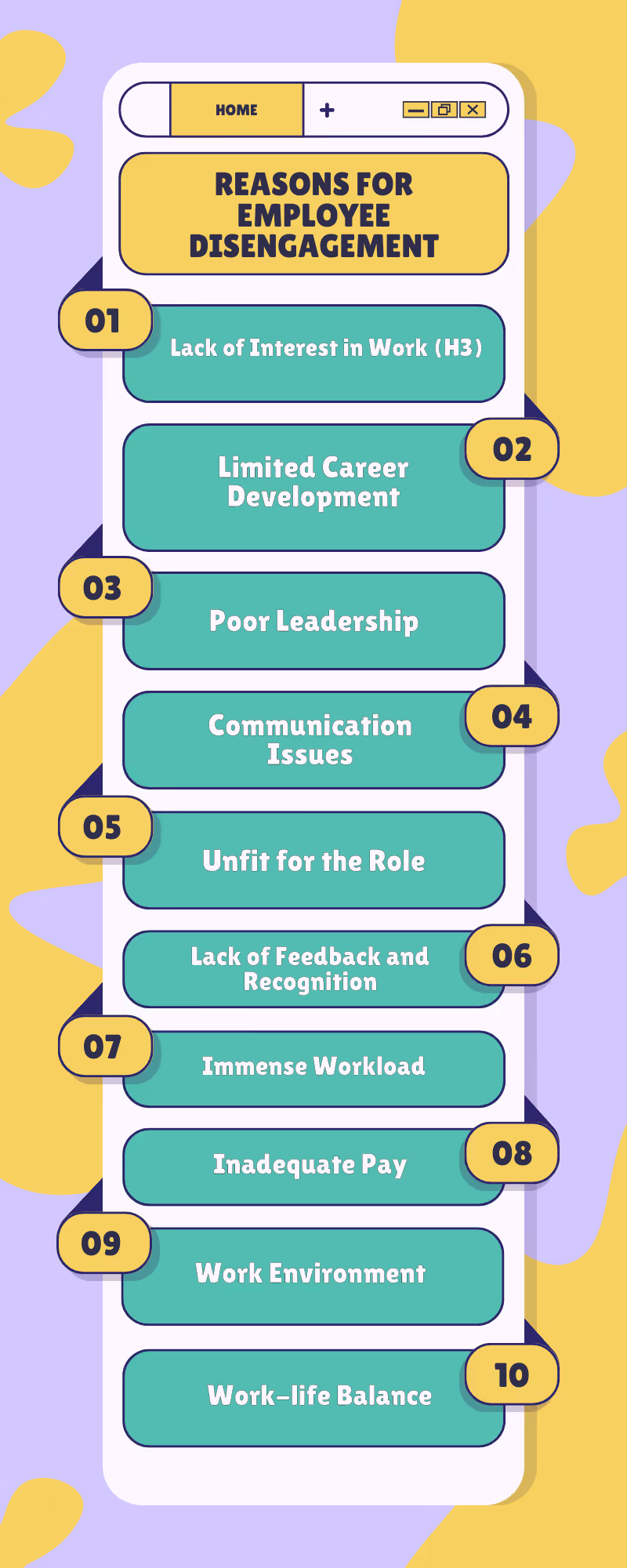
Blog
Understanding Disengaged Employees and Revitalizing Workplace Culture
April 7, 2023


Key Insights
How to Handle Disengaged Employees?
Employee disengagement is a term used in human resources that refers to the lack of commitment and enthusiasm of employees toward their work.
A disengaged employee does not enjoy their work, puts in the bare minimum effort, and is not driven to make that extra effort for improvisation.
According to a study by Leena AI titled Employee Engagement & The Hybrid Workplace Report 2022, it was found that close to 75% of organizations that participated said that their employees were not engaged in the workplace. This is an essential insight in the backdrop of increased work from home during and post-pandemic, the great resignation, and the continuing hybrid form of work.
But it's not simply working from home that makes people detached; tedious onsite jobs can also contribute to this style of functioning. In addition, the topic cannot be handled in binary where you find that the employee is either engaged or disengaged.
Rather the level of employee engagement in an organization can be divided into three categories: actively disengaged, not engaged, and actively engaged.
In a company, the highest level is often seen in the not engaged category. This level of employee disengagement is also referred to as quiet quitting.
Read on to know more.
The Trend of Quiet Quitting
Quiet quitting is a term coined by Bryan Creely, a career coach and employment influencer, but gained momentum with the TikTok hashtag and soon became a social media trend.
Though there is no clear definition of what the term means, from the employee perspective, quiet quitting is not quitting your job completely but rather prioritizing a work-life balance, where you focus on the work that is expected under contract without taking extra burden thereby giving importance to physical and mental health.
Many are unsure of what this trending phrase implies. People raise the question of how is quiet quitting different from working, where the latter also means putting in your best effort during the expected hours without compromising on the personal side.
Reasons For Employee Disengagement

- Lack of Interest in Work (H3)
One of the biggest reasons for employee disengagement is a lack of interest in the work you do. Oftentimes, employees feel unsatisfied with the work they do, stop enjoying the task at hand, and feel disconnected from it. The repetitive nature of the work can be one reason for the feeling of disengagement when the work stops exciting them to strive more.
- Limited Career Development
When employees feel a sense of stagnation in their work, where they feel further progress is not happening in their career, there starts a disengagement. Employees look for consistent betterment and upskilling in their profile and look for those companies to work with that invest in their employee’s development. Having a sense of purpose is essential to ensure engagement from the workforce.
- Poor Leadership
Leadership is a skill that can bring employees together to give their best performance. When such a figure is lacking in a company, employees will eventually lose that sense of direction and enthusiasm at work. A company headed by people who can lead by example, listen to the views and opinions of the employees, and streamline all resources for the growth of the company will motivate the team to strive better.
- Communication Issues
Communication is the key to the smooth functioning of any organization. There might be a number of reasons why your employee is not able to give their best performance. It might be a personal or professional reason that is ruining their inner peace and preventing them from functioning consistently.
Whatever the reason, the work environment must be created such that employees are comfortable opening up and feel heard. These support systems will give a sense of belongingness which will ultimately enhance their attachment and engagement with the company.
- Unfit for the Role
There might be situations when the employee is unfit for the job. It might be that their potential is not suitable for their current role, it might be that their qualification is either underqualified or overqualified for the position, or it might be that their interest is not in the current work that they do.
Several reasons can make a person unfit for the role. Hence, it's important to understand what best suits their talents and potential thereby fixing them to a role or task.

- Lack of Feedback and Recognition
The workforce is the greatest asset of an organization that can bring a variety of ideas and perspectives to the table. Hence it's important to validate their presence and efforts through feedback and recognition.
Employees like to be appreciated for the work they do, it will boost their confidence in getting the work done and encourage them to better participate in the everyday functioning of the office and their respective work.
- Immense Workload
When employees feel overburdened with a large amount of work, they will fall tired and eventually lose interest in their work. Especially among the GenZ workforce, employees give a lot of importance to work-life balance, quality of life, and physical and mental health.
They will not sustain any such workload which will lead to them eventually losing interest and commitment to the work. Assigning attainable tasks will help focus on the work with interest and get it done on time and with precision.
- Inadequate Pay
Monetary compensation is an integral part of anyone getting a job. Having decent pay that can cover the everyday needs of the employee and take care of their personal requirements, will take the headache of their head to focus on their work.
Even after putting in a lot of effort, if the employee is not feeling secure financially, then they might start disengaging from their work and thinking of various other aspects. Hence, companies must make employees feel protected and secure to ensure commitment and trust from them.
- Work Environment
A healthy work environment will bring the best out of an employee. An environment that encourages them to learn and upskill, an environment that seeks their opinion and makes them feel heard, an environment that gives a sense of belongingness and purpose, and an environment where employees feel validated for the effort they put, it will surely ensure better engagement from the employee.
- Work-life Balance
Having a job that keeps a strictly professional and personal boundary, that gives a balance to the employees to get their work done optimally and take care of their family responsibilities without compromise will in return get the commitment of the employee where they contribute their best and impact in the company's growth and development.
Identifying Employee Disengagement
.jpeg)
For the smooth and healthy functioning of the organization, it is important to keep a close check on the employees. Keeping a tab on their professional and personal well-being will help companies know what sort of assistance they require to function smoothly in the workspace, aligning with proactive approaches of sales planning that prioritize employee engagement and satisfaction as integral components of overall success.
Hence companies need to recognize when their employees begin to disengage from their work.
- When employees show poor quality of work where they do the bare minimum to get through the day, completing just what is required without putting in any extra effort, managers must realize that it is a red flag to identify a disengaging employee. Decreasing productivity rate, getting late for submissions, and not meeting deadlines are instances that they must notice as signs to improve the situation for the better.
- An equal participation of employees in every stage of the operations is necessary to pool a variety of ideas and streamline them for better results. But when an employee is withdrawing from such participation by only being present for the most important events and not being a team player, that is a sign of employee disengagement.
- Absenteeism must always be followed by a valid reason. Most often employees have a substantial reason why they could not be present for the day. But when they are not producing such grounds and are just not there, companies must take up action to understand their core reason and do the required to rectify the cause.
- A negative attitude is not desirable in a workspace. When an employee shows such behavior, it must be noticed immediately and handled with consideration. Having an empathetic conversation with them will help them understand what is the actual cause of such an attitude, understand them better, and sort the issue amicably.
Combating Employee Disengagement
Irrespective of industries like like manufacturing, retail, life sciences, the increasing remote work has made it a challenge to bring each employee under a common roof.
The current work scenario, where employees are scattered across geographical boundaries, following various time zones, and streamlined through technology, proactive and creative techniques are necessary to rid of the disengaged at work condition.
The Leena AI’s study suggests employee disengagement at work can be proactively dealt through:
- Talk less, listen more
- Set goals together
- Provide clear expectations
- Tap into employee strengths
- Monitor the employee-manager relationship
- Seek customer testimonials
- Invest in career development
- Offer flexibility
- Recognize and reward staff
These steps will help organizations maintain an employee-friendly ambiance where they feel belonged, appreciated, and validated. Positive reaffirmations like recognitions and rewards through incentive compensation plan help employees feel happy, satisfied, encouraged, and motivated to participate in the everyday operations of the company with dedication, commitment, and passion.
It is a fact that employee disengagement is on the rise in the current work scenario, but it is the responsibility of the organization and its management to ensure that they resolve the issue proactively and creatively.
Kennect as an incentive compensation and performance management solution helps keep track of your employee performance and engagement thereby ensuring they work with commitment and dedication. To know more about Kennect's solutions, book a demo today!
ReKennect : Stay ahead of the curve!
Subscribe to our bi-weekly newsletter packed with latest trends and insights on incentives.
Thank you! Your submission has been received!
Oops! Something went wrong while submitting the form.
Your data is in safe hands. Check out our Privacy policy for more info















